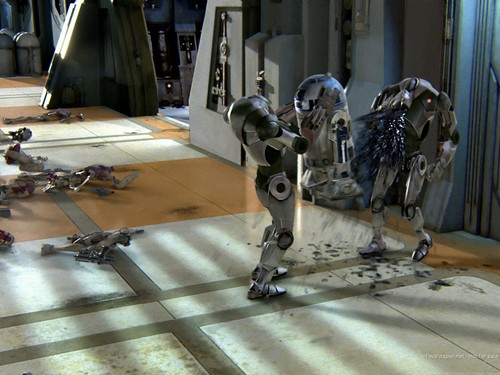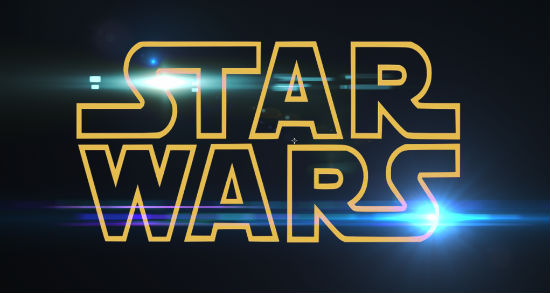Star Wars is meant for kids. George Lucas agreeing to take the rights to sell T-shirts and lunchboxes and plastic snowtroopers in lieu of a pay hike is proof of that. Star Wars has always been meant for kids. But it was its ability to draw in everyone else that made it one of the most commercially successful films in history. Adjusted for inflation, only Avatar and Gone with the Wind fare better. Despite its monolithic cultural influence, no other Star Wars movie comes close to beating A New Hope.
Far more intelligent people than I have tried to explain why the prequels were seen by so many as a disappointment, but it was never really the children that it disappointed. There’s a complicated discussion to be had about whether that’s because kids will accept anything as long as it’s shiny or whether adults are just cynical and greedy, but I think it’s fairly uncontroversial to say that the prequels focused more sharply on that younger demographic. The Phantom Menace, in particular, set the tone, with its Roger-Roger tin-can comedy bad guys, a nine-year old protagonist and everything to do with the Gungans. But even Revenge of the Sith, the only movie in the trilogy not to be granted a fully family-friendly rating, spends its opening see-sawing between Artoo’s slapstick cargo bay antics and Anakin’s adventures in dismemberment and beheading.

So now we have a sequel trilogy, and as far as I can tell, critics and media pundits are falling over themselves to point out that these movies need to recapture the magic of the originals, however they currently choose to define that nebulous trait. Actual news on the movies is slim to non-existent, but the persistent rumours of Han, Luke and Leia in more than cameo roles seems to lend at least some credence to the notion that Disney agrees. Still, the only major project not cancelled outright or condemned to some sort of canonical limbo, is Rebels – a cartoon for children. The Clone Wars cartoon seems to be the only other project likely granted immunity from the impending reshuffle of What Really Happened a long time ago in that galaxy far, far away.
Star Wars is all ages. But I don’t think Star Wars has, for a very long time, been meant for all ages all at once.
In the period immediately following the movies, the franchise continued mainly through cartoons and direct to television movies about Ewoks and Droids. Despite being published in the era that saw Watchmen revolutionize the comic industry’s self-image, I don’t think many would point to the Marvel comics as a specific contributor to that demographic shift, and computer games were still firmly aimed at twelve-year-olds.
It wasn’t until a decade later that the balance shifted. Timothy Zahn’s Thrawn Trilogy sold fifteen million copies and, in practical terms, marked the start of the Expanded Universe as a consciously cohesive endeavour. An endeavour aimed primarily at the adults who remembered the movies, not the kids who saw them every Christmas.
Sure there were still young readers’ books – Star Wars continued to provide this next generation of children with gifts just as strange as the last.

Still, the separation was increasingly obvious. By the time The Phantom Menace was trying to get us to laugh as Anakin Skywalker accidentally blew up the Trade Federation Control Ship, the New Jedi Order was setting us up to watch Anakin Solo die at seventeen in its philosophical opus on violence and pain.
Then again, isn’t the tragedy of Darth Vader an opus on violence and pain? Doesn’t the original trilogy subject all three of its leads to torture? It’s not a glib comparison: Satine Kryze’s ultimately doomed exhortation to pacifism and Jacen Solo’s re-education in the Embrace of Pain are absolutely similar in function. That the former is presented in animation and the latter in one of the most controversial novels in canon is a matter of execution and target audience, not what it means to be Star Wars. Star Wars is for all ages.
When you think about it, it was ahead of the curve; that realization that a franchise can change and grow up with its fans. How many reboots and remakes do we have now that rely on childhood nostalgia shifted just enough to appeal to someone ten years older? The relaunched line of Muppet movies was well-received critically. The relaunched Transformers films are a standing joke, but at least made a boatload of cash. The Robocop remake is fascinating in its attempts to blend its legacy as both an R-rated film franchise and a kids’ cartoon into an incoherent PG-13 that can deliver neither the bloody violence nor genuine philosophy it limply hints at.
Ultimately, nothing can really provide an accurate case study because nothing has the same depth of legacy and cultural impact. Harry Potter might compete on breadth of appeal, but so far Rowling seems content to leave it as a self-contained septology. Star Trek, on the other hand, is broadly analogous in terms of generational influence and standing in society, but has never had that fundamental conflict in terms of target audience.

JJ Abrams approached his Star Trek reboot with surprising respect for existing canon and a clear agenda: to move away from the camp cheesiness of the sixties and the formulaic predictability of the nineties. He made it sexier, edgier; even the oft-mocked lens flares seem calculated to add a sense of gritty realism – a technological grounding designed to draw our attention to the camera work – at the same time it evokes a glaringly bright future. Still, he’s known for action thrillers and harder science fiction than the sequel trilogy’s space operatics are likely to offer.
When people talk about the need to recapture the magic of A New Hope, I think they’re talking about that need to capture a universal sense of wonder. I think the prequels demonstrated that you can’t manage that by focusing only on the children in the audience (or at least, if you do, you need to turn out a better product, and now that we’ve been bitten, we’ll be twice as shy of a similar approach). I hope the sequels don’t prove an opportunity to learn that the reverse won’t work either. Not because greedy adults should keep their fingers out of children’s entertainment – I’ve always been confused by people who bought the Harry Potter books with Special Grown Up Covers – but because Star Wars really is for all ages. All of them. At once.
Abrams’ Trek defines itself, in many ways, against its former incarnations. I believe the bottled lightning of A New Hope’s 1977 debut lay in its ability to show its audience something new and appeal to a sense of optimistic nostalgia at the same time. Lucas set out to reinvent the Flash Gordon serials, which were, at the time, 40 years old. Disney and Abrams are in a better position. They can also reach back 40 years, but what they’ll find is more Star Wars.
